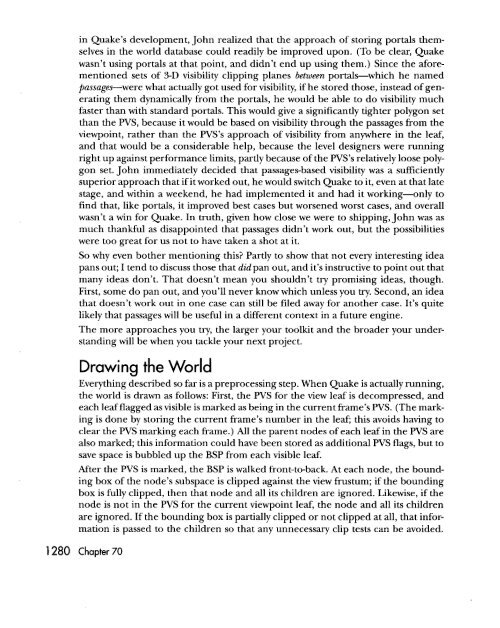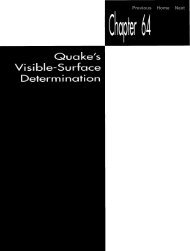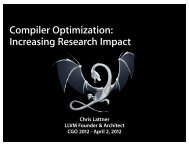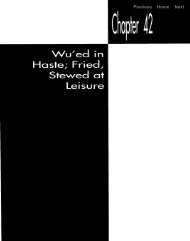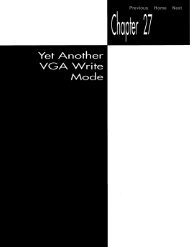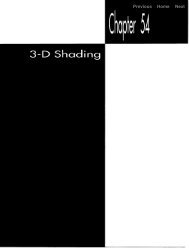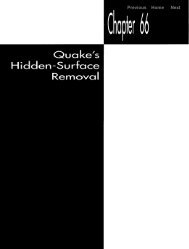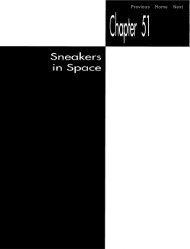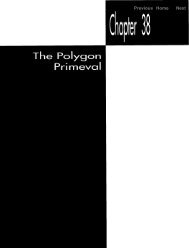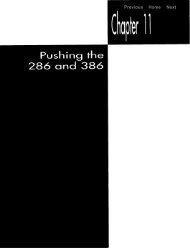quake: a post-mortem and a glimpse into the future
quake: a post-mortem and a glimpse into the future
quake: a post-mortem and a glimpse into the future
You also want an ePaper? Increase the reach of your titles
YUMPU automatically turns print PDFs into web optimized ePapers that Google loves.
in Quake’s development, John realized that <strong>the</strong> approach of storing portals <strong>the</strong>mselves<br />
in <strong>the</strong> world database could readily be improved upon. (To be clear, Quake<br />
wasn’t using portals at that point, <strong>and</strong> didn’t end up using <strong>the</strong>m.) Since <strong>the</strong> aforementioned<br />
sets of 3-D visibility clipping planes between portals-which he named<br />
pussuge+were what actually got used for visibility, if he stored those, instead of generating<br />
<strong>the</strong>m dynamically from <strong>the</strong> portals, he would be able to do visibility much<br />
faster than with st<strong>and</strong>ard portals. This would give a significantly tighter polygon set<br />
than <strong>the</strong> PVS, because it would be based on visibility through <strong>the</strong> passages from <strong>the</strong><br />
viewpoint, ra<strong>the</strong>r than <strong>the</strong> PVS’s approach of visibility from anywhere in <strong>the</strong> leaf,<br />
<strong>and</strong> that would be a considerable help, because <strong>the</strong> level designers were running<br />
right up against performance limits, partly because of <strong>the</strong> PVS’s relatively loose polygon<br />
set. John immediately decided that passages-based visibility was a sufficiently<br />
superior approach that if it worked out, he would switch Quake to it, even at that late<br />
stage, <strong>and</strong> within a weekend, he had implemented it <strong>and</strong> had it working-only to<br />
find that, like portals, it improved best cases but worsened worst cases, <strong>and</strong> overall<br />
wasn’t a win for Quake. In truth, given how close we were to shipping, John was as<br />
much thankful as disappointed that passages didn’t work out, but <strong>the</strong> possibilities<br />
were too great for us not to have taken a shot at it.<br />
So why even bo<strong>the</strong>r mentioning this? Partly to show that not every interesting idea<br />
pans out; I tend to discuss those that did pan out, <strong>and</strong> it’s instructive to point out that<br />
many ideas don’t. That doesn’t mean you shouldn’t try promising ideas, though.<br />
First, some do pan out, <strong>and</strong> you’ll never know which unless you try. Second, an idea<br />
that doesn’t work out in one case can still be filed away for ano<strong>the</strong>r case. It’s quite<br />
likely that passages will be useful in a different context in a <strong>future</strong> engine.<br />
The more approaches you try, <strong>the</strong> larger your toolkit <strong>and</strong> <strong>the</strong> broader your underst<strong>and</strong>ing<br />
will be when you tackle your next project.<br />
Drawing <strong>the</strong> World<br />
Everything described so far is a preprocessing step. When Quake is actually running,<br />
<strong>the</strong> world is drawn as follows: First, <strong>the</strong> PVS for <strong>the</strong> view leaf is decompressed, <strong>and</strong><br />
each leaf flagged as visible is marked as being in <strong>the</strong> current frame’s PVS. (The marking<br />
is done by storing <strong>the</strong> current frame’s number in <strong>the</strong> leaf; this avoids having to<br />
clear <strong>the</strong> PVS marking each frame.) All <strong>the</strong> parent nodes of each leaf in <strong>the</strong> PVS are<br />
also marked; this information could have been stored as additional PVS flags, but to<br />
save space is bubbled up <strong>the</strong> BSP from each visible leaf.<br />
After <strong>the</strong> PVS is marked, <strong>the</strong> BSP is walked front-to-back. At each node, <strong>the</strong> bounding<br />
box of <strong>the</strong> node’s subspace is clipped against <strong>the</strong> view frustum; if <strong>the</strong> bounding<br />
box is fully clipped, <strong>the</strong>n that node <strong>and</strong> all its children are ignored. Likewise, if <strong>the</strong><br />
node is not in <strong>the</strong> PVS for <strong>the</strong> current viewpoint leaf, <strong>the</strong> node <strong>and</strong> all its children<br />
are ignored. If <strong>the</strong> bounding box is partially clipped or not clipped at all, that information<br />
is passed to <strong>the</strong> children so that any unnecessary clip tests can be avoided.<br />
1280 Chapter 70


